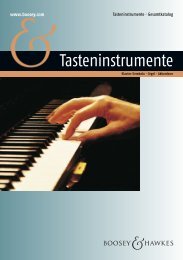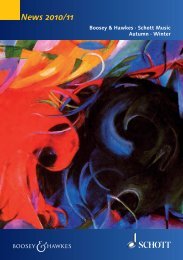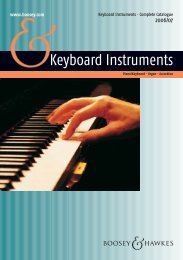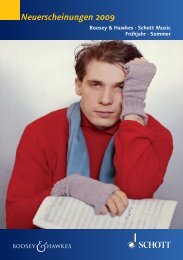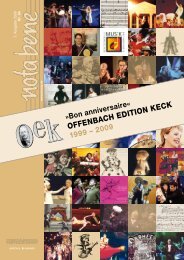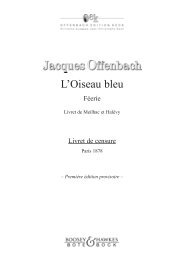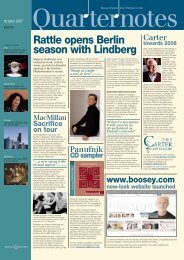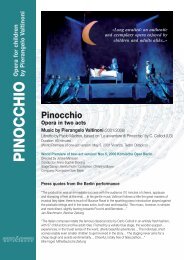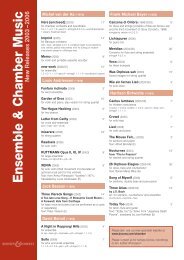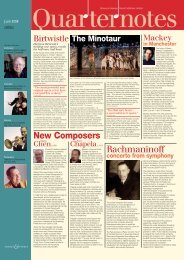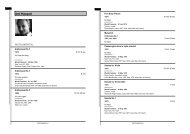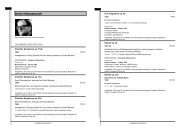You also want an ePaper? Increase the reach of your titles
YUMPU automatically turns print PDFs into web optimized ePapers that Google loves.
Beyer<br />
<strong>Frank</strong> <strong>Michael</strong>
Ronald Darden and David Nixon in “Orpheus-Stationen”, Tom Schilling’s three-act ‘choreographic<br />
essay on a myth’ to a libretto by Hermann Neef, designs & costumes by Wolf-E. Lange, with music by<br />
Schreker, Stravinsky and <strong>Frank</strong> <strong>Michael</strong> Beyer: Geburt des Tanzes (for first act, “Traum der Sehnsucht”),<br />
Deutsche Oper Berlin 1988 (WP, see p.14).<br />
Photo: kranichphoto
TABLE OF CONTENTS<br />
<strong>Frank</strong> <strong>Michael</strong> Beyer<br />
Biography & Introduction 2<br />
German 2<br />
English 7<br />
Abbreviations 12<br />
Works 14<br />
Ballet 14<br />
Full Orchestra 15<br />
Chamber Orchestra 17<br />
Solo Instrument(s) and Orchestra 19<br />
Ensemble and Chamber without Voice(s) 22<br />
Instrumental 28<br />
Voice(s) 32<br />
Arrangements 34<br />
Works with other publishers 35<br />
Recordings 36<br />
Boosey & Hawkes addresses 38<br />
Composers list 40<br />
Cover photo: Stefan Moses<br />
Translations: Andreas Goebel<br />
Printed by DMP Digital- und Offsetdruck, Berlin<br />
Feb 2008<br />
TABLE OF CONTENTS 1
BIOGRAPHIE<br />
1928 geboren in Berlin als Sohn des Schriftstellers Oskar<br />
Beyer; Kindheit in Dresden, Kreta, Athen, Liechtenstein<br />
1938 Besuch des Kant-Gymnasiums, Berlin<br />
1946–1949 Studien in Komposition und Kirchenmusik<br />
(Kirchenmusikschule Berlin)<br />
1950–1953 Klavierstudien in Leipzig; Fortsetzung des Kompositionsstudiums<br />
bei Ernst Pepping und Virtuoses<br />
Orgelspiel bei Joseph Ahrens an der Hochschule für<br />
Musik Berlin<br />
1950–1963 Tätigkeit als Kirchenmusiker<br />
seit 1950 vielfältige Konzerttätigkeit als Orgelinterpret und Dirigent<br />
1953–1962 Dozent an der Kirchenmusikschule Berlin<br />
1960 Lehrtätigkeit an der Hochschule für Musik Berlin<br />
1964 Initiator der Reihe »Musica nova sacra«<br />
1968–1993 Kompositionsprofessur an der Hochschule der Künste<br />
Berlin<br />
1970–1985 Leitungsmitglied der Berliner Bach-Tage<br />
1986–2003 Direktor der Abteilung Musik der Akademie der Künste,<br />
Berlin<br />
1990 Initiator des Instituts für Neue Musik an der Hochschule<br />
der Künste Berlin<br />
Ehrungen (unter anderem):<br />
1958 Kunstpreis der Stadt Berlin für die Junge Generation<br />
1961 Bernhard Sprengel-Preis für Kammermusik<br />
1963 Villa Massimo-Stipendium (Rom), Villa Romana-<br />
Stipendium (Florenz)<br />
1968 Stipendium der Cité des Arts Paris<br />
seit 1979 Mitglied der Akademie der Künste, Berlin<br />
seit 1981 Mitglied der Bayerischen Akademie der Schönen<br />
Künste, München<br />
1997 Ehrengast der Villa Massimo (Rom)<br />
BIOGRAPHIE 2
EINFÜHRUNG<br />
An ihren Werken sollt ihr sie erkennen: Der biblische Satz gilt für<br />
Komponisten weit mehr noch als für die Allgemeinheit, an die er<br />
gerichtet war. Mit ihren Werken greifen die Kreativen in ihre Gegenwart<br />
ein. In ihnen überschreiten sie zugleich die Grenzen der Zeit;<br />
sie wenden sich mit dem, was sie schreiben, an ihre Mitmenschen,<br />
an ihre Zeitgenossen, aber auch – voraus weisend – an Generationen,<br />
die sie nicht kennen und von denen sie nichts wissen. So wird<br />
im musikalischen Werk die Zeit zur Hoffnung und die Hoffnung zur<br />
erfüllten Zeit.<br />
Und zur Geschichte. Diese gewinnt Sinn durch den Horizont der<br />
Zukunft und Substanz durch die Vergangenheit, auf der sie ruht.<br />
In <strong>Frank</strong> <strong>Michael</strong> Beyers Kompositionen sind beide Dimensionen<br />
der Geschichte gegenwärtig; darin liegt ein Teil ihres spezifischen<br />
Zeitbewusstseins. Im weiten Universum der Musikhistorie gewannen<br />
für den Sohn eines Schriftstellers zwei Komponisten als »Fixsterne«<br />
besondere Bedeutung: Johann Sebastian Bach und Anton<br />
Webern. Die Musik Bachs kannte er von Kindheit an; sein Vater<br />
veröffentlichte in den zwanziger Jahren im Berliner Furche-Verlag<br />
ein Buch über den Mann, den er mit Max Reger für das A und das<br />
O der abendländischen Musikgeschichte hielt. Bach blieb für <strong>Frank</strong><br />
<strong>Michael</strong> Beyer Gegenstand immer frischer Neugierde und immer<br />
neuer Entdeckungen. Mit der Musik Anton Weberns wurde er während<br />
seiner Studienzeit in den frühen fünfziger Jahren bekannt. Er<br />
fand bei beiden nicht nur Strenge des Denkens, sondern die Befreiung,<br />
die eine vollkommene Beherrschung kompositorischer Methoden<br />
für die musikalische Vor- und Darstellung bedeutet. Immer<br />
wieder setzte er sie zueinander in Konstellation und verlängerte<br />
dabei den Spannungsbogen, der sie verbindet, in zwei Richtungen:<br />
hin zu dem, was Bach bereits zur Voraussetzung hat, und hin zu<br />
dem, was aus Webern folgen könnte. In die feine Polyphonie, die<br />
Schichtungen und Gruppierungen des 2003 uraufgeführten Chorwerks<br />
Et resurrexit ist auch die Betrachtung der alten vielstimmigen<br />
Werke eines Josquin oder eines Thomas Tallis mit eingegangen; die<br />
Erfahrung, wie aus einem immer engeren Geflecht der Stimmen im<br />
Verlauf der Zeit gleichsam ein atmender, intensiv bewegter Klang<br />
wird. Dieser Zeit-Bogen zieht sich, mehr oder weniger offenkundig,<br />
mehr oder weniger bestimmend, durch das gesamte Schaffen<br />
von <strong>Frank</strong> <strong>Michael</strong> Beyer. Er wirkt in der Fuga fiammata für Orchester,<br />
generiert aus der Tonfolge, die »Bach im Schlusssatz seiner<br />
e-Moll-Partita thematisiert hat«. Sie ist, wie Webernsche Reihen,<br />
aus einer Zelle von drei Tönen entwickelt und lenkt das musikalische<br />
Geschehen geheimnisvoll aus dem Hintergrund, tritt nur an<br />
markanten Positionen deutlich hervor. Dieses Denken in Tongruppen<br />
und Tonskalen ist charakteristisch für die jüngeren Werke <strong>Frank</strong><br />
EINFÜHRUNG 3
EINFÜHRUNG<br />
<strong>Michael</strong> Beyers. Es verbindet ihn mit den Grundgedanken heutigen<br />
Schaffens jenseits von Serialität, elektronischer Musik und postmodernen<br />
Re-Kreationen.<br />
Mit Bach – und in gewisser Weise auch mit Webern – lässt <strong>Frank</strong><br />
<strong>Michael</strong> Beyer die Einteilung der geistigen Welt in streng abgegrenzte<br />
Zonen nicht gelten: hier Kunst, dort Wissenschaft, hier<br />
christliche Tradition, dort antikes Denken, hier geistliche, dort<br />
weltliche Musik. Sein Œuvre enthält zwar ausgesprochen geistliche<br />
Werke wie die Biblischen Szenen, die Manifestatio Christi<br />
oder das Canticum Mose et Agni für acht- bis zwölfstimmigen<br />
Chor, ebenso Werke, die eindeutig für den säkularen Konzertsaal<br />
bestimmt sind, aber auch Werke der Grenzüberschreitung, ein<br />
Streichquartett, das Missa heißt und dessen Sätze Titel aus dem<br />
Ordinarium der Messe tragen, und die Liturgia, die Fassung des<br />
Quartetts für Streichorchester. Religion und Philosophie, Glauben<br />
und Denken bilden für ihn keine Gegensätze, sie gehören zur Welterfahrung<br />
und aus ihnen speist sich die Kraft, Neues zu gestalten.<br />
Die Mythen und die Kunst der Antike, in denen die Musik ins<br />
Zentrum des Menschenlebens führt, sind in Werken wie dem Ballett<br />
Geburt des Tanzes, Griechenland für großes Orchester und<br />
dem Violinkonzert Musik der Frühe gegenwärtig: als gedankliche<br />
Tore einer ästhetischen Erfahrung, die aus den Bruchstücken des<br />
Hier und Jetzt ins Offene und zugleich Zusammenhängende des<br />
Zeit-Raums Geschichte weist.<br />
Wer mit <strong>Frank</strong> <strong>Michael</strong> Beyer über seine Werke spricht, wird einen<br />
großen Teil der Unterhaltung mit Arbeiten anderer Komponisten<br />
und deren Hintergründen zubringen – und gerade dadurch Wesentliches<br />
über Beyers eigenes Komponieren erfahren. Denn die musikalische<br />
Komposition ist für ihn Ausdruck einer geistigen Welt, die<br />
viele Quellen und Äußerungsformen kennt. Ein Gespräch mit ihm<br />
über Bachs h-Moll-Messe führt zu vielen Entdeckungen, an denen<br />
Fachliteratur vorbeigeht. Sie stammen aus der eigenen Erfahrung,<br />
aus der Neugier des kreativen Künstlers, für den Forschen, Erkennen<br />
und Gestalten zusammen gehören. Ein Gespräch über Skrjabin<br />
öffnet den Horizont für einen spezifischen Weg der Moderne als<br />
eines Versprechens, das noch nicht eingelöst ist.<br />
<strong>Frank</strong> <strong>Michael</strong> Beyers Wirken beschränkt sich nicht auf das Komponieren<br />
allein. Für den »homo culturalis« gehört die Vermittlung<br />
von Erkenntnis und Erfahrung mit zur Arbeit. Er gab sein Wissen<br />
und Können als Lehrer für Komposition an der Hochschule der<br />
Künste (heute: Universität der Künste) an seine Studierenden<br />
weiter, er gründete dort das Institut für Neue Musik, initiierte die<br />
EINFÜHRUNG 4
EINFÜHRUNG<br />
Reihe »Musica nova sacra«, mit der die Kluft zwischen avancierter<br />
Musik und gebrauchsästhetisch orientierter Kirchenmusik überwunden<br />
wird, er verantwortete die Berliner Bachtage, und war<br />
für die Berufskollegen im Aufsichtsrat der GEMA tätig. 1986 bis<br />
2003 leitete er die Musiksektion der Berliner Akademie der Künste,<br />
der er seit 1979 angehört, seit 1981 ist er außerdem Mitglied der<br />
Bayerischen Akademie der Schönen Künste.<br />
In den letzten Jahren treten einige Züge in Beyers Komponieren<br />
deutlicher hervor, die in früheren Werken bereits angelegt waren,<br />
aber eher aus dem Hintergrund auf die Strukturen einwirkten. Sie<br />
hängen einerseits mit Konfigurationen des strikt musikalischen<br />
Denkens, andererseits mit der gesellschaftlichen Situation und Verantwortung<br />
der Künste zusammen. Das Œuvre seit 2003 enthält<br />
einen außergewöhnlich hohen Anteil solistischer Werke – entweder<br />
für ein Instrument allein, wie die Metamorphosen für Violine solo<br />
(Hommage à A. Skrjabin), oder für ein Soloinstrument mit Orchester,<br />
wie das Violakonzert Notte di pasqua oder das Flötenkonzert<br />
Meridian – beide erweiterte er nach Abschluss der ersten Fassung<br />
um einen nachkomponierten Satz oder Satzteil zur endgültigen<br />
Werk-Architektur. Selbst die Choreographie für zwölf Violoncelli<br />
zieht ihre Energie über weite Strecken aus der Spannung zwischen<br />
solistischer und chorischer Bewegungsinitiative. Im Klaviertrio<br />
Lichtspuren trägt der mittlere Satz, das Kernstück des Werkes, die<br />
Polarität zwischen solistischem Klavier und den beiden Streichern<br />
auch als Konflikt zwischen Behauptung und Sozialisierung des Individuellen<br />
aus.<br />
Der gesellschaftlichen Einsicht antwortet bei <strong>Frank</strong> <strong>Michael</strong> Beyer<br />
die kompositorische Stringenz. Sie kristallisiert sich in seinen neuen<br />
Werken vor allem um das Verhältnis von Melos und Klang. Ein<br />
Beispiel dafür geben die Metamorphosen, eine Reflexion über<br />
Skrjabins sechste Klaviersonate, die Beyer schon in seiner Studienzeit<br />
faszinierte. Teils bewegtes, teils fragiles, teils insistierendes<br />
Melos tritt in ihr aus stehendem, oft aufrauschendem Klang hervor<br />
wie Feinzeichnungen eines geheimnisvollen Raumes. In ihren stetig<br />
sich weitenden Kreisläufen ist das Imaginäre jenseits der physischen<br />
Musikgestalt mitkomponiert. Beyer geht mit seinen Metamorphosen<br />
den Weg in Gegenrichtung – aus dem Melos zum Klang.<br />
Dabei erscheint der imaginäre Anteil des harmonischen Raums<br />
vergrößert, die Form weitet sich noch stärker als bei Skrjabin,<br />
bleibt bei dessen Material, aber zieht in andere Ausdrucksbereiche.<br />
Zeit erscheint in dieser frei fließenden Musik nicht länger mehr<br />
als Taktzwang, sondern gleichsam als Schale, als Gefäß, das die<br />
Musik auffängt.<br />
EINFÜHRUNG 5
EINFÜHRUNG<br />
Im Flötenkonzert Meridian tauen zu Beginn die harten Akkorde der<br />
Streicher unter den virtuosen Einstrahlungen der Soloflöte allmählich<br />
auf. Dieser Vorgang, der in ein kurzes Solo der Flöte mündet,<br />
bildet das Portal zu einem Werk, das in seiner endgültigen Fassung<br />
konzentrisch angelegt ist und diese Form – ein typisch musikalisches<br />
Paradox – in der Zeit entrollt. Zwei zarte, kurze Intermezzi<br />
– das erste für die Soloflöte allein, das zweite im Dialog mit der<br />
ersten Violine – rahmen ein kraftvoll-dynamisches Zentralstück<br />
und werden ihrerseits von einem Eingangssatz, der die Perspektiven<br />
öffnet, und einem Schlussstück, das »motivisch gewonnene<br />
Elemente im tragenden Melos verdichtet«, umfangen. Der Grundgedanke,<br />
im Werktitel zum Begriff geworden, wird in einer Polyphonie<br />
der gedanklichen Schichten auf verschiedenen Ebenen der<br />
Komposition wirksam: in ihrer konzentrischen Anlage; in jenem<br />
Zentralton »h«, der die zentrifugalen Kräfte des dritten Satzes auch<br />
dort sammelt und ordnet, wo er nicht zu hören ist, und in den sich<br />
der Verlauf des Satzes mehrmals bündelt; schließlich in den Soli,<br />
die das Zentralstück umgeben und ihre Entsprechungen, ihren Vor-<br />
und Widerschein, auch in den anderen Sätzen finden.<br />
Dass im Spätwerk eines Künstlers die Fragen nach den letzten<br />
Dingen in den Vordergrund rücken, scheint sich als unverwüstlicher<br />
Gemeinplatz bis heute zu halten. Der Überprüfung hält er nicht<br />
stand. Fragen von Leben, Endlichkeit und Ewigkeit, von Liebe,<br />
Tod und Vollendung sah <strong>Frank</strong> <strong>Michael</strong> Beyer nie an eine Altersstufe<br />
gebunden. Seine neuesten Werke zeichnen sich, gegen das<br />
verbreitete Vorurteil, durch einen luziden, feinnervigen, bisweilen<br />
leuchtenden Klang aus.<br />
Notte di pasqua nannte er sein Bratschenkonzert, das 2004 nach<br />
der Musik der Frühe (1992/93) für Violine und Orchester und<br />
dem Violoncellokonzert Canto di giorno (1998/99) die Trilogie der<br />
Konzerte für ein Streichinstrument mit Orchester abschloss. Lichtspuren<br />
überschrieb er sein Klaviertrio (2006). »Der Titel deutet auf<br />
die Macht des flutenden Lichts, hat aber gleichzeitig innerkompositorischen<br />
Bezug zu aufleuchtend tragenden musikalischen<br />
Brückenschlägen« (F. M. Beyer). Die Metapher des Lichts verweist<br />
auf die Hauptlinien des geistigen Erbes, aus dem wir leben: auf die<br />
griechische Antike, die jüdisch-christliche Überlieferung und auf<br />
die Aufklärung, den »Ausgang des Menschen aus seiner selbstverschuldeten<br />
Unmündigkeit« (Kant).<br />
Habakuk Traber, 2008<br />
EINFÜHRUNG 6
BIOGRAPHY<br />
1928 Born in Berlin, son of the author Oskar Beyer;<br />
he spent his childhood in Dresden, Crete, Athens,<br />
and Liechtenstein<br />
1938 Attended the Kant-Gymnasium (secondary school)<br />
in Berlin<br />
1946–1949 Studies in composition and church music (Berlin School<br />
of Church Music)<br />
1950–1953 Piano studies in Leipzig; further composition studies at<br />
the Hochschule für Musik in Berlin with Ernst Pepping<br />
and organ studies with Joseph Ahrens<br />
1950–1963 Church musician<br />
since 1950 Various concert performances as organist and conductor<br />
1953–1962 Lecturer at the Kirchenmusikschule Berlin<br />
1960 Lecturer at the Hochschule für Musik Berlin<br />
1964 Initiator of the series “Musica nova sacra”<br />
1968–1993 Professorship in composition at the Hochschule der<br />
Künste Berlin<br />
1970–1985 Co-director of the Berlin Bach Festival<br />
1986–2003 Director of the Berlin Academy of Arts’ music department<br />
1990 Initiator of the Institut für Neue Musik at the Hochschule<br />
der Künste Berlin<br />
Honours (among others):<br />
1958 Art Prize of the City of Berlin for the Young Generation<br />
1961 Bernhard Sprengel Prize for chamber music<br />
1963 Fellowship at the Villa Massimo (Rome), Fellowship at<br />
the Villa Romana (Florence)<br />
1968 Fellowship at the Cité des Arts in Paris<br />
since 1979 Member of the Berlin Academy of Arts<br />
since 1981 Member of the Bavarian Academy of Fine Arts, Munich<br />
1997 Guest of Honour at the Villa Massimo (Rome)<br />
BIOGRAPHY 7
INTRODUCTION<br />
“Let your light shine so before men, that they may see your good<br />
works.” This sentence from the Bible applies to composers even<br />
more than to the general public it was addressed to. Their works<br />
connect with the present and yet, simultaneously, they transcend<br />
the limits of time, speaking not only to their contemporaries, but<br />
also to the generations they do not know and who know nothing<br />
of them. Thus, in a musical work, time becomes hope and hope<br />
becomes time fulfilled.<br />
Works of art look back to history as well. History gains significance<br />
through the horizon of the future and substance through the past<br />
on which it rests. Both these dimensions of history are present in<br />
<strong>Frank</strong> <strong>Michael</strong> Beyer’s compositions, to a certain extent accounting<br />
for their inherent sense of time. Within the vast universe of music<br />
history, there are two composers who became universal benchmarks<br />
for Beyer: Johann Sebastian Bach and Anton Webern. He<br />
knew Bach’s music from his childhood years, his father having<br />
published a book on the man he considered to be, along with<br />
Max Reger, the be-all and the end-all of Western music. For <strong>Frank</strong><br />
<strong>Michael</strong> Beyer, Bach remained an object of eternal curiosity, a mine<br />
of constant discoveries. It was during his studies in the 1950s that<br />
Beyer also became acquainted with the music of Anton Webern.<br />
It was not only their strictness of thought that drew him towards<br />
these two composers. They also made him realise the liberating<br />
effect that the absolute command of compositional methods had<br />
on musical imagination and representation. Time and again, he<br />
juxtaposed Bach and Webern in various constellations, extending<br />
the arc of tension between them in two directions. Firstly,<br />
towards the historical foundations on which Bach composed his<br />
works and, secondly, towards the possible future developments to<br />
follow from Webern’s music. The delicate polyphony and the layers<br />
and groupings of his choir work Et resurrexit, premiered in 2003,<br />
were inspired by the old, many-voiced works of composers like<br />
Josquin or Thomas Tallis. In particular, it was the idea of transforming<br />
an increasingly dense network of parts into an almost breathing,<br />
vibrant sound. This arch of time runs through <strong>Frank</strong> <strong>Michael</strong><br />
Beyer’s whole output – sometimes more manifest and decisive,<br />
sometimes less. It can be felt in the Fuga fiammata for orchestra,<br />
generated from the sequence of notes that “Bach made the subject<br />
of the final movement of his Partita in E minor.” Like Webern’s<br />
tone rows, the sequence is based on a three-note cell and mysteriously<br />
directs the musical process from the background, coming<br />
to the surface only at significant moments. This way of structuring<br />
the music in groups and scales of notes is characteristic of Beyer’s<br />
earlier works. It suggests a similarity to the basic ideas of today’s<br />
INTRODUCTION 8
INTRODUCTION<br />
composers, beyond serialism, electronic music and post-modern<br />
re-creations.<br />
His experience of Bach – and in a certain sense of Webern, too<br />
– makes it impossible for <strong>Frank</strong> <strong>Michael</strong> Beyer to divide the spiritual<br />
world into neatly marked zones: art here, science there, Christian<br />
tradition here, ancient thought there, religious music here, secular<br />
there. It is true that he wrote distinctly religious works, like Biblische<br />
Szenen (Biblical Scenes), Manifestatio Christi or Canticum Mose<br />
et Agni for an eight- to twelve-part choir, as well as works that are<br />
clearly intended for secular concert halls. However, he also wrote<br />
music across traditional borderlines – a string quartet bearing the<br />
title Missa, the movements of which are taken from the Ordinary of<br />
the Mass, or Liturgia, the adaptation of the quartet for string orchestra.<br />
Religion and philosophy, faith and reason are no opposites for<br />
Beyer, both rather part of his perception of the world, informing<br />
the power to create new things. The myths and art of antiquity,<br />
where music leads to the heart of human life, are present in works<br />
such as the ballet Geburt des Tanzes (Birth of Dance), Griechenland<br />
(Greece) for large orchestra and the violin concerto Musik der<br />
Frühe (Music of Daybreak). Here, they are intellectual gateways to<br />
an aesthetic experience that points from the fragments of the hereand-now<br />
into the open. And yet, this openness is where the space<br />
of historical time assumes a sense of cohesion.<br />
Talking to <strong>Frank</strong> <strong>Michael</strong> Beyer about his works means discussing<br />
the work of other composers and their background for most of<br />
the time. You soon realise, however, that this is one way of understanding<br />
some essential points about Beyer’s own work. After all,<br />
he sees musical composition as an expression of a spiritual world<br />
that has many sources and manifestations. A conversation about<br />
Bach’s Mass in B minor reveals many discoveries that have gone<br />
unnoticed by academics. They have grown out of Beyer’s own<br />
experience, having sprung from the curiosity of an artist for whom<br />
exploration, understanding and creation are all part of the same<br />
process. Another conversation, about Scriabin, unfolds a horizon in<br />
which the particular way of modernist music appears as a promise<br />
still awaiting redemption.<br />
Beyer’s work is not limited to composing music. Being a true ‘homo<br />
culturalis’, passing on knowledge and experience is part of his<br />
work. Teaching at the former Berlin Arts College (now a University),<br />
he shared his understanding and expertise with composition students.<br />
While there, he also founded the Institute of New Music and<br />
launched the “Musica nova sacra” series, a project which bridged<br />
INTRODUCTION 9
INTRODUCTION<br />
the gulf between the avant-garde and functional music for use in<br />
church. He organised the Berlin Bach Days and was a member of<br />
the supervisory board of the GEMA, the German organisation for<br />
the management of reproduction rights for artists. Between 1986<br />
and 2003 he was director of the music department of the Berlin<br />
Academy of the Arts, where he has been a member since 1979. In<br />
addition to this, the Bavarian Academy of Fine Arts also appointed<br />
him a member in 1981.<br />
In recent years, certain features of Beyer’s work have become<br />
more prominent than in earlier works, where they had already existed,<br />
but more as a structural force, remaining in the background.<br />
They affect not only configurations of musical ideas but also the<br />
role and responsibility of art in society. His œuvre after 2003 shows<br />
an extraordinary amount of solo works – either for one soloist, like<br />
the Metamorphosen (Hommage à A. Scriabin) for solo violin, or for<br />
a solo instrument with orchestra, like the viola concerto Notte di<br />
pasqua and the flute concerto Meridian. After finishing the first versions<br />
of the two latter works, Beyer added a movement or section<br />
in each that he had composed later to complete their final architecture.<br />
Even Choreographie, not a solo work but a piece for twelve<br />
cellos, mostly draws its energy from the tension between solo and<br />
choral impulses. In the middle movement – the core section – of<br />
the piano trio Lichtspuren (Light Traces), one aspect of the polarity<br />
between solo piano and the two string instruments is the conflict<br />
between assured individualism on the one hand and socialisation<br />
of the individual on the other.<br />
For <strong>Frank</strong> <strong>Michael</strong> Beyer, compositional consistency is a response<br />
to his social perception. In his more recent works, this consistency<br />
crystallises mainly in the relation of melos and sound. An example<br />
of this is Metamorphosen, a reflection on Scriabin’s sixth piano<br />
sonata, which had already fascinated Beyer during his years of<br />
study. In the sonata, partly moving, partly insistent melos flows<br />
from stagnant or effervescent sounds like the minute drawings of<br />
a secret space. In constantly expanding cycles, the imaginary is<br />
woven into the music, beyond its physical shape. Metamorphosen,<br />
however, shows Beyer taking the opposite route – melos emerging<br />
from sound. Here the imaginary seems to occupy even more<br />
space within the harmonic scope, form expanding further than in<br />
Scriabin’s work, using the same material but exploring a different<br />
range of expression. In this freely floating music, time is no longer<br />
a rigid measurement scheme but appears, rather, to be a kind of<br />
bowl, a vessel enfolding the music.<br />
INTRODUCTION 10
INTRODUCTION<br />
At the beginning of the flute concerto Meridian, the hard string<br />
chords seem to be gradually melting when the virtuoso solo flute<br />
‘radiates’ into them. This process, which merges into a short flute<br />
solo, is the gateway to a work which, in its final form, is laid out<br />
concentrically. This form – a typically musical paradox – is unfolded<br />
in time. Two tender, short intermezzi – one for the soloist alone, the<br />
other a conversation between flute and violin – enclose a powerful<br />
and dynamic central section. The intermezzi themselves are framed<br />
by an introduction that opens up large perspectives and a concluding<br />
piece which “condenses elements developed as motifs in an<br />
all-embracing melos”. This basic idea, as expressed in the title,<br />
informs the composition on various levels, developing it into a sort<br />
of intellectual polyphony. One such level, for example, is the work’s<br />
concentric structure. Another is the central note B-flat, which pulls<br />
together and arranges the centrifugal powers everywhere in the<br />
third movement, even when it is not heard, and into which the<br />
course of the whole movement converges several times. Lastly,<br />
there are the solos surrounding the central section, which are<br />
reflected in correspondences and reverberations throughout all the<br />
movements.<br />
The idea that, in their later works, artists focus on transcendent<br />
matters is an ever-recurring truism. It does not, however, bear verification.<br />
For <strong>Frank</strong> <strong>Michael</strong> Beyer, issues of life, finality and eternity,<br />
of love, death and fulfillment have never been reserved for a certain<br />
age. As if opposed to this widespread cliché, his latest works feature<br />
a lucid, subtle and sometimes luminescent sound.<br />
Notte di pasqua is the title of his viola concerto, which in 2004<br />
completed a trilogy of concertos for a string instrument with orchestra,<br />
following Musik der Frühe (1992/93) for violin and orchestra<br />
and the cello concerto Canto di giorno (1998/99). His piano trio is<br />
called Lichtspuren (2006). “The title suggests the power of flooding<br />
light, but at the same time it is a reference to the composition itself,<br />
to flaring, supporting bridgings” (Beyer). The metaphor of light<br />
points to the main currents of the spiritual legacy we all draw on:<br />
Greek antiquity, Jewish-Christian tradition and the enlightenment,<br />
“man’s emergence from self-incurred immaturity” (Kant).<br />
Habakuk Traber, 2008<br />
INTRODUCTION 11
ABBREVIATIONS<br />
Deutsch English Français Italiano<br />
Holzbläser Woodwind Bois Legni<br />
picc Piccoloflöte piccolo petite flûte ottavino<br />
fl Flöte flute grande flûte flauto<br />
afl Altflöte alto flute flûte alto flauto contralto<br />
bfl Baßflöte bass flute flûte basse flauto basso<br />
rec Blockflöte recorder flûte à bec flauto dolce<br />
ob Oboe oboe hautbois oboe<br />
corA Englischhorn cor Anglais (English horn) cor anglais corno inglese<br />
cl Klarinette<br />
(in A oder Bb)<br />
clarinet<br />
(in A or Bb)<br />
clarinette<br />
(en la ou en si bémol)<br />
clarinetto<br />
(in la o in si bemolle)<br />
bcl<br />
E bcl Baßklarinette<br />
Es-Klarinette<br />
bass clarinet<br />
clarinet in E b<br />
clarinette basse<br />
petite clarinette<br />
clarinetto basso<br />
clarinetto in mi bemolle<br />
dbcl Kontrabaß klarinette double bass clarinet clarinette contrebasse clarinetto contrabbasso<br />
sax Saxophon saxophone saxophone sassofono<br />
bn Fagott bassoon basson fagotto<br />
dbn Kontrafagott double bassoon/<br />
contrabassoon<br />
contrebasson controfagotto<br />
Blechbläser Brass Cuivres Ottoni<br />
hn Horn horn cor corno<br />
crt Kornett cornet cornet cornetta<br />
flgn Flügelhorn flugelhorn bugle flicorno<br />
tpt Trompete trumpet trompette tromba<br />
trbn Posaune trombone trombone trombone<br />
btrbn Baßposaune bass trombone trombone basse trombone basso<br />
Schlagwerk Percussion Percussion<br />
Strumenti a<br />
percussione<br />
BD große Trommel bass drum grosse caisse grancassa<br />
bl Block block block block<br />
cast Kastagnetten castanets castagnettes castagnette<br />
chin.cym chinesisches Becken Chinese cymbal cymbales chinoises piatto cinese<br />
crot Crotales crotales crotales crotales<br />
cym Becken cymbal(s) cymbale(s) piatto/i<br />
dr Trommel/Drum drum tambour/drum tamburo/drum<br />
glsp Glockenspiel glockenspiel glockenspiel glockenspiel<br />
perc Schlagzeug/Percussion percussion percussion percussione<br />
SD kleine Trommel snare drum caisse claire tamburo militare<br />
susp.cym hängendes Becken suspended cymbal cymbale suspendue piatto sospeso<br />
(einzeln)<br />
(single)<br />
(seule)<br />
(singolo)<br />
t.bells Röhrenglocken tubular bells cloches tubulaires campane tubolari<br />
tamb Tamburin tambourine tambour de basque tamburello basco<br />
tam-t Tam-Tam tam-tam Tam-Tam tam-tam<br />
TD Wirbeltrommel tenor drum caisse roulante tamburo rullante<br />
tgl Triangel triangle triangle triangolo<br />
timp Pauken timpani timbales timpani<br />
tom-t Tom-Toms tom-toms Tom-Toms tom-tom<br />
tpl.bl Tempelblock(s) temple block(s) temple block(s) block cinese/i<br />
vib Vibraphon vibraphone vibraphone vibrafono<br />
wdbl Woodblock(s) woodblock(s) woodblock(s) woodblock<br />
xyl Xylophon xylophone xylophone xilofono<br />
Tasteninstrumente Keyboards Claviers<br />
Strumenti<br />
a tastiera<br />
pft Klavier piano piano pianoforte<br />
cel Celesta celesta célesta celesta<br />
hpd Cembalo harpsichord clavecin clavicembalo<br />
org Orgel organ orgue organo<br />
kbd Keyboard keyboard keyboard keyboard<br />
synth Synthesizer synthesizer synthesizer sintetizzatore<br />
ABBREVIATIONS 12
ABBREVIATIONS<br />
Streicher Strings Cordes archi<br />
vln Violine violin violon violino<br />
vla Viola viola alto viola<br />
vlc Violoncello cello violoncelle violoncello<br />
db Kontrabaß double bass/contrabass contrebasse contrabbasso<br />
Stimmen Voices Voix Voci<br />
colS Koloratursopran coloratura soprano soprano léger soprano leggero<br />
S Sopran soprano soprano soprano<br />
M Mezzosopran mezzo-soprano mezzo-soprano mezzosoprano<br />
A Alt alto alto contralto<br />
CT Countertenor countertenor contraténor contratenore<br />
T Tenor tenor ténor tenore<br />
dramBar dramatischer Bariton dramatic baritone bariton dramatique baritono drammatico<br />
highBar hoher Bariton high baritone bariton aigu baritono alto<br />
lyrBar lyrischer Bariton lyric baritone bariton lyrique baritono lirico<br />
Bar Bariton baritone bariton baritono<br />
BBar Baßbariton bass baritone bariton-basse basso-baritono<br />
B Baß bass basse basso<br />
Sprachen Languages Langues Lingue<br />
E englisch English anglais inglese<br />
F französisch French français francese<br />
G deutsch German allemand tedesco<br />
I italienisch Italian italien italiano<br />
Sonstiges Others Divers Diversi<br />
ampl verstärkt amplified amplifié amplificato<br />
ca circa circa circa circa<br />
elec. elektrisch/elektronisch electric/electronic électrique/électronique elettrico/elettronico<br />
gtr Gitarre guitar guitare chitarra<br />
hi hoch high aigu alto<br />
lg groß large grand grande<br />
lo tief low grave basso<br />
max. Maximum maximum maximum massimo<br />
med mittel medium moyen medio<br />
min Minuten minutes minutes minuti<br />
min. Minimum minimum minimum minimo<br />
sm klein small petit piccolo<br />
Alle übrigen Instrumentenangaben sind ausgeschrieben oder eine Kombination<br />
der obigen Kürzel. Standardreihenfolge der Instrumente:<br />
fl.ob.cl.bn—hn.tpt.trbn.tuba—perc—sonstige—vlnI.vlnII.vla.vlc.db<br />
Hinweise zu Kaufausgaben finden sich bei den einzelnen Werkeinträgen.<br />
Wo nicht anders vermerkt, ist das Aufführungsmaterial leihweise erhältlich.<br />
Werkkommentare und Pressestimmen zu den Stücken finden sich unter<br />
www.boosey.de/Beyer<br />
All other scorings are listed in full, or are a combination of the above.<br />
Standard order of instrumentation:<br />
fl.ob.cl.bn—hn.tpt.trbn.tuba—perc—other—vlnI.vlnII.vla.vlc.db<br />
Material on sale is indicated after each work entry. Where no parts are listed on<br />
sale, the work is available for rental.<br />
Programme notes and press reviews for the works can be found at<br />
www.boosey.com/Beyer<br />
ABBREVIATIONS 13
BALLET<br />
Geburt des Tanzes<br />
1987 45 min<br />
Ballet (under the title: Orphische Szene)<br />
4(=picc,afl,bfl).3(III=corA).3(III=bcl).3(III=dbn)—4.3.3.1—timp.perc—<br />
harp—pft—strings<br />
Commissioned by the Berliner Festspiele for »Berlin – Kulturstadt Europas<br />
1988«<br />
World Premiere: 27 Mar 1988<br />
Deutsche Oper, Berlin , Germany<br />
Tom Schilling, choreographer<br />
Ballettensemble & Orchester der Deutschen Oper Berlin<br />
Conductor: Spiros Argiris<br />
Das Fenster<br />
1991 30 min<br />
Ballet by Lothar Höfgen, incorporating music from<br />
Griechenland (1981) and Action (1991)<br />
timp.perc(5)—strings(12.10.8.6.4)<br />
World Premiere: 27 Mar 1992<br />
Opernhaus, Hannover , Germany<br />
Lothar Höfgen, choreographer<br />
Das Ballett des Niedersächsischen Staatstheaters Hannover<br />
Das Niedersächsische Staatsorchester Hannover<br />
Conductor: Hans Herbert Jöris<br />
Mario Alejandro Silva in<br />
Lothar Höfgen’s Magritteinspired<br />
ballet “Das Fenster”,<br />
designs & costumes by Vera<br />
Sobat, with music by <strong>Frank</strong><br />
<strong>Michael</strong> Beyer, Hannover<br />
1992 (WP, see above).<br />
Photo: Joachim Giesel<br />
BALLET 14
FULL ORCHESTRA<br />
Rondeau imaginaire<br />
1972 12 min<br />
for orchestra<br />
3(III=picc).2.2.2—2.2.0.0—timp.perc(3):glsp/vib/marimba—harp—pft—<br />
strings(12.0.8.6.3)<br />
Commissioned by the Berliner Festwochen<br />
979-0-2025-1197-8 Study score<br />
World Premiere: 20 Sep 1973<br />
Philharmonie, Berlin , Germany<br />
Radio-Symphonie-Orchester Berlin<br />
Conductor: Lorin Maazel<br />
Diaphonie<br />
1975 20 min<br />
for orchestra<br />
3(I=afl,III=picc).2.2(II=bcl).2—4.2.2.1—timp.perc(4):vib/3wdbl/<br />
4cym/4tam-t/crot/t.bells/3tgl/BD/TD/2bongos/3tom-t—harp—pft—<br />
strings(with solo string quartet)<br />
Commissioned by the Nürnberger Musiktheater<br />
979-0-2025-1352-1 Study score<br />
World Premiere: 26 Feb 1976<br />
Meistersingerhalle, Nürnberg , Germany<br />
Das Philharmonische Orchester der Stadt Nürnberg<br />
Conductor: Jirˇí Bělohlávek<br />
Notre-Dame-Musik<br />
1983/84 16 min<br />
for orchestra<br />
3(III=picc).3(III=corA).2.bcl.3—4.3.3.1—timp.perc—harp—strings<br />
World Premiere: 02 Nov 1984<br />
Kongreßhalle, Großer Saal, Saarbrücken , Germany<br />
Rundfunk-Sinfonieorchester Saarbrücken<br />
Conductor: Hubert Soudant<br />
FULL ORCHESTRA 15
FULL ORCHESTRA<br />
Geburt des Tanzes<br />
1987 25 min<br />
Cycle for large orchestra, based on the ballet of the same title<br />
4(=III,IVpicc,III=afl,IV=bfl).3(III=corA).3(II=Ebcl,IV=bcl).3(III=dbn)—<br />
4.3.3.1—timp.perc(5):tom-t/BD/2tam-t/vib/marimba/cowbells/cyms/<br />
bongos/t.bells—harp—pft—strings<br />
979-0-2025-1958-5 Full score<br />
World Premiere: 10 Nov 1989<br />
Haus des Rundfunks, Großer Sendesaal, Berlin , Germany<br />
Radio-Symphonie-Orchester Berlin / Conductor: Lothar Zagrosek<br />
Klangtore<br />
(original version in seven movements)<br />
1996 25 min<br />
for orchestra<br />
4(III=picc,IV=afl).2.corA.2.bcl.3(III=dbn)—4.4.3.1—timp.perc(4):glsp/<br />
cowbells/t.bells/4gongs/5susp.cym/4bongos/4tom-t/3tam-t/BD/vib/<br />
marimba—harp—pft—strings<br />
Commissioned by the Deutsches Symphonie-Orchester Berlin for its<br />
50th anniversary 1997<br />
979-0-2025-1957-8 Full score<br />
World Premiere: 22 May 1997<br />
Philharmonie, Berlin , Germany<br />
Deutsches Symphonie-Orchester Berlin / Conductor: Lothar Zagrosek<br />
new version in five movements: 2001 19 min<br />
World Premiere: 19 Aug 2001<br />
Konzerthaus, Berlin , Germany<br />
Jeunesses Musicales Weltorchester / Conductor: Roberto Paternostro<br />
Fuga fiammata<br />
1999/2000 16 min<br />
for orchestra<br />
3(III=picc,afl).2.corA.2.bcl.3(III=dbn)—4.3.3.1—timp.perc(4):6susp.cym/<br />
4bongos/4tom-t/3tam-t/vib/marimba/7gongs—harp—pft—strings<br />
Commissioned by the Bayerischer Rundfunk for its »musica viva« series<br />
979-0-2025-3046-7 Full score<br />
World Premiere: 15 Jun 2001<br />
Herkulessaal der Residenz, München , Germany<br />
Symphonieorchester des Bayerischen Rundfunks / Conductor: Ulf Schirmer<br />
FULL ORCHESTRA 16
CHAMBER ORCHESTRA<br />
Ricercare I<br />
1957 20 min<br />
for small orchestra<br />
2fl.2cl.bcl—harp—strings<br />
World Premiere: 1958<br />
Berlin , Germany<br />
Radio-Symphonie-Orchester Berlin<br />
Conductor: Wolfgang Sawallisch<br />
Versi<br />
1968 11 min<br />
for string orchestra<br />
strings(4.4.3.3.1)<br />
979-0-2025-1105-3 Study score<br />
World Premiere: 07 Oct 1968<br />
Philharmonie, Berlin , Germany<br />
Berliner Philharmonisches Orchester<br />
Conductor: Hans Zender<br />
Concertino a tre<br />
1974 14 min<br />
for trumpet, trombone, double bass,<br />
two oboes and double string quartet<br />
World Premiere: 22 May 1974<br />
Linker Zirkelbau, Schwetzingen , Germany<br />
Robert Bodenröder, trumpet / Armin Rosin, trombone /<br />
Harro Bertz, double bass / Südwestdeutsches Kammerorchester Pforzheim<br />
Conductor: Paul Angerer<br />
Streicherfantasien<br />
(version for string orchestra)<br />
1977 14 min<br />
on a Motif by Johann Sebastian Bach<br />
strings(7.6.5.4.3)<br />
979-0-2025-1377-4 Full score<br />
World Premiere: 12 Mar 1980<br />
Philharmonie, Berlin , Germany<br />
Berliner Philharmonisches Orchester<br />
Conductor: Giuseppe Sinopoli<br />
CHAMBER ORCHESTRA 17
CHAMBER ORCHESTRA<br />
Griechenland<br />
Musik für drei Streichergruppen<br />
1981 21 min<br />
for three groups of strings<br />
strings(12.10.8.6.4)<br />
979-0-2025-1429-0 Full score<br />
World Premiere: 22 Jun 1982<br />
Philharmonie, Berlin , Germany<br />
Berliner Philharmonisches Orchester<br />
Conductor: Seiji Ozawa<br />
Musikalisches Opfer (1985)<br />
see Arrangements<br />
Liturgia<br />
(after String Quartet No.3 »Missa«)<br />
1996 20 min<br />
for string orchestra<br />
979-0-2025-1975-2 Full score<br />
World Premiere: 24 Jan 1997<br />
Konzerthaus, Großer Saal, Berlin , Germany<br />
Rundfunk-Sinfonieorchester Berlin<br />
Conductor: Lawrence Foster<br />
Passionato con Arietta<br />
Elegie für Streicher<br />
2005 15 min<br />
for strings<br />
strings(4.4.3.2.1, or string orchestra:8.8.6.4.2)<br />
World Premiere: 16 Dec 2006<br />
Stiftskirche, Diez an der Lahn , Germany<br />
Camerata Bern<br />
Conductor: Erich Höbarth<br />
CHAMBER ORCHESTRA 18
SOLO INSTRUMENT(S) AND ORCHESTRA<br />
Konzert für Orgel und sieben Instrumente (1966/69)<br />
see Ensemble and Chamber without Voice(s)<br />
Concertino a tre (1974)<br />
see Chamber Orchestra<br />
Deutsche Tänze<br />
1982 12 min<br />
for cello and double bass with chamber orchestra<br />
1(=picc).2.1.2—1.1.0.0—strings<br />
979-0-2025-1393-4 Solo parts (2 Playing scores)<br />
World Premiere: 13 Jun 1984<br />
Berlin , Germany<br />
Jörg Baumann, cello / Klaus Stoll, double bass<br />
Robert-Schumann-Kammerorchester<br />
Conductor: Jürgen Kußmaul<br />
Mysteriensonate<br />
1986 18 min<br />
for orchestra, with solo viola<br />
3(III=picc).3(III=corA).3(III=bcl).3(III=dbn)—4.3.3.0—timp.perc—harp—<br />
pft—strings<br />
World Premiere: 16 May 1987<br />
Haus des Rundfunks, Großer Sendesaal, Berlin , Germany<br />
Thomas Turner, viola<br />
Radio-Symphonie-Orchester Berlin<br />
Conductor: Sylvain Cambreling<br />
Konzert für Oboe und Streichorchester<br />
1986 18 min<br />
Concerto for oboe and string orchestra<br />
also see below Canzona di Ombra and Wie ein fernes Lied<br />
979-0-2025-1727-7 Full score<br />
World Premiere: 07 Oct 1987<br />
Philharmonie, Berlin , Germany<br />
Hansjörg Schellenberger, oboe<br />
Berliner Philharmonisches Orchester<br />
Conductor: Erich Leinsdorf<br />
SOLO INSTRUMENT(S) AND ORCHESTRA 19
SOLO INSTRUMENT(S) AND ORCHESTRA<br />
Canciones (1991)<br />
see Ensemble and Chamber without Voice(s)<br />
Musik der Frühe<br />
1992/93 27 min<br />
Concerto for violin and orchestra<br />
2(II=picc).2.2(II=bcl).2(II=dbn)—2.2.1.1—timp.perc(3):4wdbl/4bongos/<br />
4tom-t/5susp.cym/BD/2tam-t(med,lo)/t.bells/vib/cowbells—harp—<br />
pft—strings(not too many)<br />
Commissioned by the Berliner Festwochen<br />
979-0-2025-1956-1 Full score<br />
World Premiere: 11 Sep 1993<br />
Schauspielhaus, Großer Konzertsaal, Berlin , Germany<br />
Kolja Blacher, violin<br />
Rundfunk-Sinfonieorchester Berlin<br />
Conductor: Hanns-Martin Schneidt<br />
Canto di giorno<br />
1998/99 20 min<br />
for cello and orchestra<br />
1(=picc).1.corA.1.bcl.1—1.1.1.0—perc(2):vib/marimba/t.bells—harp—<br />
strings(8.6.4.4.3)<br />
Commissioned by the Rundfunk-Sinfonieorchester Berlin for its 75th<br />
anniversary 1998<br />
979-0-2025-1976-9 Full score<br />
World Premiere: 16 Apr 1999<br />
Haus des Rundfunks, Großer Sendesaal, Berlin , Germany<br />
<strong>Michael</strong> Sanderling, cello<br />
Rundfunk-Sinfonieorchester Berlin<br />
Conductor: Giuseppe Mega<br />
Canzona di Ombra<br />
1986/2003 8 min<br />
for solo oboe and strings<br />
Cadenza and final movement of the Konzert für Oboe und<br />
Streichorchester (see above), for separate performance<br />
strings(solo version: 4.4.3.2.1)<br />
SOLO INSTRUMENT(S) AND ORCHESTRA 20
SOLO INSTRUMENT(S) AND ORCHESTRA<br />
Konzert für Viola und Orchester<br />
»Notte di pasqua«<br />
2003–04/06 25 min<br />
Concerto for viola and orchestra<br />
1.1.corA.1.bcl.1—1.1.1.1—perc(3):vibr/mar/6susp.cym/t.bells/3tam-t/<br />
BD/6gongs—harp—strings(not too many)<br />
979-0-2025-3210-2 Piano reduction<br />
World Premiere: 18 Mar 2007<br />
Philharmonie, Großer Saal, Berlin , Germany<br />
Tabea Zimmermann, viola<br />
Deutsches Symphonie-Orchester Berlin<br />
Conductor: Jonathan Stockhammer<br />
Meridian<br />
Konzert für Flöte und Streicherensemble<br />
2004/05 20 min<br />
Concerto for flute and string ensemble<br />
strings(4.4.3.2.1)<br />
World Premiere: 02 Mar 2008<br />
Nikolaisaal, Potsdam , Germany<br />
Emmanuel Pahud, flute<br />
Kammerakademie Potsdam<br />
Conductor: <strong>Michael</strong> Sanderling<br />
Cadenza dolce (2007)<br />
see Arrangements<br />
SOLO INSTRUMENT(S) AND ORCHESTRA 21
ENSEMBLE AND CHAMBER WITHOUT VOICE(S)<br />
Streichquartett I<br />
String Quartet No.1<br />
1954/56 35 min<br />
979-0-2025-1847-2 Score & parts<br />
World Premiere: 1957<br />
(Studio performance)<br />
World Public Premiere: 1961<br />
Hannover , Germany<br />
Hamann-Streich quartett<br />
Konzert für Orgel und sieben Instrumente<br />
1966/69 15 min<br />
Concerto for organ and seven instruments<br />
fl.ob—tpt—harp—vla.vlc.db<br />
World Premiere of version: 11 Apr 1969<br />
Martinskirche, Kassel , Germany<br />
Peter Schwarz, organ<br />
Kasseler Ensemble<br />
Conductor: Hermann Emmerling<br />
Streichquartett II<br />
String Quartet No.2<br />
1969 10 min<br />
979-0-2025-1104-6 Study score<br />
World Premiere: 06 Nov 1969<br />
Konzertsaal Bundesallee, Berlin , Germany<br />
Assmann-Quartett<br />
Bläserquintett<br />
Wind Quintet<br />
1972 11 min<br />
fl.ob.cl.bn—hn<br />
979-0-2025-1213-5 Study score<br />
979-0-2025-1214-2 Parts<br />
World Premiere: 15 Jul 1973<br />
Akademie der Künste , Berlin , Germany<br />
Bläserquintett des Südwestfunks Baden-Baden<br />
ENSEMBLE AND CHAMBER WITHOUT VOICE(S) 22
ENSEMBLE AND CHAMBER WITHOUT VOICE(S)<br />
Streicherfantasien<br />
(version for string quintet)<br />
1977 14 min<br />
on a Motif by Johann Sebastian Bach<br />
979-0-2025-1377-4 Full score<br />
World Premiere: 18 Sep 1978<br />
Hochschule der Künste, Theatersaal, Berlin , Germany<br />
Brandis Quartett / Rolf Ranke, double bass<br />
De lumine<br />
1978 12 min<br />
Music for chamber ensemble<br />
fl(=afl).cl—perc:3cym/3tom-t/vib/marimba—pft—vln.vla.vlc<br />
979-0-2025-1395-8 Full score<br />
World Premiere: 03 Jan 1979<br />
NDR, Hamburg , Germany<br />
Ensemble »das neue werk«<br />
Conductor: Dieter Cichewiecz<br />
Trio<br />
1980 13 min<br />
for oboe, viola and harp<br />
979-0-2025-1627-0 Score & parts<br />
World Premiere: 04 May 1981<br />
Rosengarten, Mannheim , Germany<br />
Heinz Holliger, oboe / Hirofumi Fukai, viola / Ursula Holliger, harp<br />
»Deutsche Tänze«<br />
1980 12 min<br />
for cello and double bass<br />
979-0-2025-1393-4 2 Playing scores<br />
World Premiere: 10 Nov 1980<br />
Wien , Austria<br />
Jörg Baumann, cello / Klaus Stoll, double bass<br />
ENSEMBLE AND CHAMBER WITHOUT VOICE(S) 23
ENSEMBLE AND CHAMBER WITHOUT VOICE(S)<br />
Fantasia concertante<br />
per due violini<br />
1982 11 min<br />
for two violins<br />
979-0-2025-1477-1 2 Playing scores<br />
World Premiere: 18 Nov 1984<br />
Stadthalle, Hofheim am Taunus , Germany<br />
Mechthild Boeckheler & Klaus Assmann<br />
Passacaglia fantastica<br />
1984 13 min<br />
for violin, cello and piano<br />
979-0-2025-1538-9 Score & parts<br />
World Premiere: 15 Jun 1986<br />
Ludwigsburg , Germany<br />
Stuttgarter Klaviertrio<br />
Streichquartett III »Missa«<br />
String Quartet No.3<br />
1985 27 min<br />
979-0-2025-1692-8 Study score<br />
979-0-2025-2227-1 Parts<br />
World Premiere: 28 Sep 1985<br />
Haus des Rundfunks, Kleiner Sendesaal, Berlin , Germany<br />
Wilanow-Quartett<br />
Sinfonien für acht Stimmen<br />
1988 18 min<br />
for ensemble<br />
cl.bn—hn—strings(1.1.1.1.1)<br />
979-0-2025-1672-0 Full score<br />
World Premiere: 06 Feb 1989<br />
Philharmonie, Kammermusiksaal, Berlin , Germany<br />
Scharoun-Ensemble Berlin<br />
ENSEMBLE AND CHAMBER WITHOUT VOICE(S) 24
ENSEMBLE AND CHAMBER WITHOUT VOICE(S)<br />
Architettura per musica<br />
1989 16 min<br />
for chamber ensemble<br />
1.1.1.1—1.1.1.0—perc—harp—strings(1.1.1.1.1)<br />
World Premiere: 07 Sep 1989<br />
Philharmonie, Kammermusiksaal, Berlin , Germany<br />
musica-viva-ensemble dresden<br />
Conductor: Jürgen Wirrmann<br />
Action<br />
1991 11 min<br />
for percussion ensemble<br />
timp.perc(5):I=vib/2bongos; II=marimba/2bongos;<br />
III=4tom-t/SD(snares)/3susp.cym; IV=TD/SD(no snares)/3susp.cym;<br />
V=BD/military dr/3tam-t/t.bells<br />
979-0-2025-1829-8 Score & parts<br />
World Premiere: 16 Nov 1993<br />
Schauspielhaus, Kammermusiksaal, Berlin , Germany<br />
Super Nova Percussion Ensemble<br />
Canciones<br />
1991 21 min<br />
for clarinet and ensemble<br />
3fl(=afl)—perc—harp—strings(1.1.1.1.1)<br />
World Premiere: 01 Dec 1991<br />
Philharmonie, Kammermusiksaal, Berlin , Germany<br />
Alois Brandhofer, clarinet<br />
Mitglieder des Berliner Philharmonischen Orchesters<br />
Conductor: Peter Keuschnig<br />
Klarinettenquintett<br />
1992 12 min<br />
for clarinet and string quartet<br />
979-0-2025-1751-2 Full score<br />
World Premiere: 17 Oct 1993<br />
Neues Schloß, Weißer Saal, Stuttgart , Germany<br />
Ulf Rodenhäuser, clarinet<br />
Walter Forchert & Nina Martinez, violins / Enrique Santiago, viola /<br />
Martin Ostertag, cello<br />
ENSEMBLE AND CHAMBER WITHOUT VOICE(S) 25
ENSEMBLE AND CHAMBER WITHOUT VOICE(S)<br />
Nänie<br />
1994 10 min<br />
for two guitars<br />
979-0-2025-1963-9 2 Playing scores<br />
World Premiere: 25 Nov 1994<br />
Lüneburg , Germany<br />
Reinbert Evers & Wolfgang Weigel<br />
»Windklang«<br />
2000 8 min<br />
for string trio<br />
979-0-2025-2157-1 Score & parts<br />
World Premiere: 28 Jan 2003<br />
Musikhochschule, Konzertsaal, Stuttgart , Germany<br />
Ingolf Turban, violin / Kolja Lessing, viola / Wen-Sinn Yang, cello<br />
Was Orpheus sah<br />
Klangbilder für Streichquartett<br />
2003 15 min<br />
for string quartet<br />
979-0-2025-3164-8 Score & parts<br />
World Premiere: 09 Oct 2004<br />
Konzerthaus, Kleiner Saal, Berlin , Germany<br />
Vogler-Quartett<br />
Voca<br />
2004 9 min<br />
for three trumpets<br />
979-0-2025-3188-4 Playing score<br />
World Premiere: 20 Nov 2004<br />
Musikseminar, Hamburg , Germany<br />
Trompeten-Trio Christian Ahrens<br />
ENSEMBLE AND CHAMBER WITHOUT VOICE(S) 26
ENSEMBLE AND CHAMBER WITHOUT VOICE(S)<br />
Lichtspuren<br />
2006 25 min<br />
for piano trio<br />
pft—vln.vlc<br />
World Premiere: 11 Mar 2008<br />
Kulturzentrum Franziskanerkirche, Kempen , Germany<br />
Trio Wanderer<br />
Zu den Inseln<br />
2005/06 20 min<br />
Suite for nine instruments<br />
1.1.1.0—0.1.0.0—harp—strings(1.1.1.1.0)<br />
World Premiere: 27 Nov 2008<br />
Bayerische Akademie der Schönen Künste, München , Germany<br />
opus21musikplus<br />
Conductor: Konstantia Gourzi<br />
Choreographie<br />
Drei mythische Tänze für zwölf Violoncelli<br />
2007 12 min<br />
for twelve celli<br />
ENSEMBLE AND CHAMBER WITHOUT VOICE(S) 27
INSTRUMENTAL<br />
Toccata in Re<br />
1952 9 min<br />
for organ<br />
979-0-2025-1699-7<br />
World Premiere: 1953<br />
Matthäuskirche, Berlin , Germany<br />
<strong>Frank</strong> <strong>Michael</strong> Beyer<br />
Variationen für Klavier<br />
1957 13 min<br />
for piano<br />
979-0-2025-1698-0<br />
World Premiere: 1958<br />
Paris , France<br />
Klaus Billing<br />
Toccaten sub communione<br />
1970 8 min<br />
for organ<br />
979-0-2025-1128-2<br />
World Premiere: 15 Jun 1970<br />
Lorenzkirche, Nürnberg , Germany<br />
Peter Schwarz<br />
»Chaconne«<br />
1970 5 min<br />
for solo violin<br />
979-0-2025-1108-4<br />
World Premiere: 19 Sep 1971<br />
Kaiser-Friedrich-Gedächtniskirche, Berlin , Germany<br />
János Négyesi<br />
INSTRUMENTAL 28
INSTRUMENTAL<br />
Tiento II<br />
1972 6 min<br />
for organ<br />
979-0-2025-1210-4<br />
World Premiere: 23 May 1973<br />
Kaiser-Friedrich-Gedächtniskirche, Berlin , Germany<br />
<strong>Frank</strong> <strong>Michael</strong> Beyer<br />
Sonate für Violine und Klavier<br />
1977 13 min<br />
for violin and piano<br />
979-0-2025-1327-9 Parts<br />
World Premiere: 10 Dec 1978<br />
Hochschule der Künste, Theatersaal, Berlin , Germany<br />
Saschko Gawriloff, violin / Lothar Broddack, piano<br />
Melos I<br />
1983 6 min<br />
for solo viola<br />
979-0-2025-1530-3<br />
World Premiere: 30 Apr 1983<br />
Berlin , Germany<br />
Bernhard Herting<br />
Das Geläut zu Speyer<br />
1984 5 min<br />
for organ<br />
979-0-2025-3073-3<br />
World Premiere: 23 Sep 1984<br />
Münster, Ulm , Germany<br />
Gerd Witte<br />
INSTRUMENTAL 29
INSTRUMENTAL<br />
Echo<br />
1985 18 min<br />
for solo bass flute<br />
979-0-2025-1587-7<br />
World Premiere: 28 Feb 1986<br />
Akademie der Künste, Berlin , Germany<br />
Eberhard Blum<br />
Melos II<br />
1990 6 min<br />
for solo viola<br />
979-0-2025-1530-3<br />
World Premiere: 11 Mar 1990<br />
Akademie der Künste, Clubraum, Berlin , Germany<br />
Wolfram Christ<br />
Lobgesang »Wurze des Waldes«<br />
1992 10 min<br />
for organ<br />
Commissioned by the Evangelisch-reformierte Kirchengemeinde Stein am<br />
Rhein for its organ consecration, August 1992<br />
979-0-2025-3072-6<br />
World Premiere: 23 Aug 1992<br />
Stein am Rhein , Germany<br />
Gerd Witte<br />
Nachtstück<br />
1993 10 min<br />
for oboe and piano<br />
979-0-2025-1770-3 Parts<br />
World Premiere: 11 Mar 1990<br />
Verkehrsverein, Düsseldorf , Germany<br />
Christian Schneider, oboe / <strong>Frank</strong> <strong>Michael</strong> Beyer, piano<br />
INSTRUMENTAL 30
INSTRUMENTAL<br />
Taglied<br />
1998 6 min<br />
for cello and piano<br />
979-0-2025-1962-2 Parts<br />
World Premiere: 12 Mar 1998<br />
Sender Freies Berlin, Berlin , Germany<br />
Georg Faust, cello / Rolf Koenen, piano<br />
Imago<br />
2002 8 min<br />
for solo cello<br />
Commissioned by Walter Kugler / Rudolf-Steiner-Nachlaßverwaltung<br />
for the opening of the new archive room<br />
979-0-2025-3074-0<br />
World Premiere: 15 Nov 2002<br />
Archiv Rudolf-Steiner-Nachlassverwaltung, Dornach , Switzerland<br />
Marek Jerie<br />
Wie ein fernes Lied<br />
2004/05 3 min<br />
for solo oboe<br />
Cadenza of the Konzert für Oboe und Streichorchester (see above),<br />
for separate performance<br />
Metamorphosen<br />
Hommage à A. Skrjabin<br />
2007 15 min<br />
for solo violin<br />
World Premiere: 03 Mar 2008<br />
Haus des Rundfunks, Großer Sendesaal, Berlin , Germany<br />
Viviane Hagner<br />
INSTRUMENTAL 31
VOICE(S)<br />
Biblische Szenen<br />
1955 25 min<br />
for mezzo-soprano and tenor (or soprano and baritone)<br />
and ensemble<br />
Text: Biblical<br />
fl.ob—vln.vla<br />
World Premiere: 1956<br />
Studio des NDR, Berlin , Germany<br />
Diana Eustrati, mezzo-soprano<br />
Drei Psalmen (1966)<br />
see Arrangements<br />
Maior Angelis<br />
1970 8 min<br />
for soprano, female chorus and ensemble<br />
Text: first chapter of the “Hebräerbrief” (L)<br />
3fl.afl—org—db<br />
World Premiere: 04 Oct 1970<br />
Kaiser-Friedrich-Gedächtniskirche, Berlin , Germany<br />
Catherine Gayer, soprano<br />
Kammerchor Ernst Senff<br />
Conductor: <strong>Frank</strong> <strong>Michael</strong> Beyer<br />
Canticum Mose et Agni<br />
1976 12 min<br />
for eight-part unaccompanied choir<br />
Text: Moses II/15; Revelation of St. John 15,1–4 (L/G)<br />
Commissioned by the 51. Bach-Fest der Neuen Bach-Gesellschaft 1976<br />
979-0-2025-1320-0 Choral score<br />
World Premiere: 16 Jul 1977<br />
Berlin , Germany<br />
Monteverdi Choir<br />
Conductor: John Eliot Gardiner<br />
VOICE(S) 32
VOICE(S)<br />
Et resurrexit<br />
Chor Motetten<br />
2001/02 21 min<br />
for twelve-part mixed chorus a cappella<br />
Text: (L)<br />
Commissioned by the Rundfunkchor Berlin<br />
979-0-2025-3070-2 Choral score (Motet I)<br />
979-0-2025-3071-9 Choral score (Motets II & III)<br />
World Premiere: 16 Mar 2003<br />
Philharmonie, Berlin , Germany<br />
Rundfunkchor Berlin<br />
Conductor: Simon Halsey<br />
Scene from Paul Taylor’s ballet “Musical Offering / Musikalisches Opfer”, designs<br />
& costumes by Gene Moore, to J.S. Bach’s music in the arrangement by <strong>Frank</strong><br />
<strong>Michael</strong> Beyer (see following page) and Webern, Deutsche Oper Berlin (German<br />
premiere 13 Feb 1987 (WP by the Paul Taylor Dance Company, New York 1986).<br />
Photo: kranichphoto<br />
VOICE(S) 33
ARRANGEMENTS<br />
Drei Psalmen<br />
by Boris Blacher, arranged by <strong>Frank</strong> <strong>Michael</strong> Beyer<br />
1943, arr.1966 8 min<br />
for baritone and piano, arranged for baritone and ensemble<br />
Text: Psalms 142, 141, 121<br />
cl.bn—org—vln.vla.vlc<br />
World Premiere: 13 Nov 1966<br />
Kaiser-Friedrich-Gedächtnis-Kirche, Berlin , Germany<br />
Herbert Brauer, baritone<br />
Conductor: <strong>Frank</strong> <strong>Michael</strong> Beyer<br />
Musikalisches Opfer<br />
Die kontrapunktischen Sätze<br />
Ricercare a 3, Fuga canonica & 9 Kanons<br />
by Johann Sebastian Bach, arranged by <strong>Frank</strong> <strong>Michael</strong> Beyer<br />
arr.1985 35 min<br />
for chamber orchestra, for performance together with the<br />
arrangement of Bach’s Ricercare a 6 by Anton Webern<br />
1.1.corA.1.bcl.1—1.1.0—harp—strings(1.0.1.1.1, or small string<br />
orchestra)<br />
World Premiere: 14 Jul 1985<br />
Philharmonie, Berlin , Germany<br />
London Sinfonietta<br />
Conductor: Diego Masson<br />
Cadenza dolce<br />
for the Andante in C Major for flute and orchestra K315 by W.A. Mozart<br />
2007 2 min<br />
for solo flute<br />
World Premiere: 02 Mar 2008<br />
Nikolaisaal, Potsdam , Germany<br />
Emmanuel Pahud<br />
ARRANGEMENTS 34
WORKS WITH OTHER PUBLISHERS<br />
Lays for organ (1957)<br />
Bärenreiter Verlag<br />
Sprache der Liebenden for bariton, chamber chorus and orchestra<br />
(Hölderlin) (1961)<br />
Rundfunk Berlin-Brandenburg RBB, archive<br />
Lavatio – Manifestatio Christi for mixed chorus a cappella (1962)<br />
Bärenreiter Verlag<br />
Sonate for viola and organ (1962)<br />
Bärenreiter Verlag<br />
Tiento for flute and organ (1965)<br />
Bärenreiter Verlag<br />
Konzert for flute and string orchestra (1967)<br />
Bärenreiter Verlag<br />
Canti dei misteri for organ (1979)<br />
Schott Music<br />
Messesätze (Josquin/Beyer) for organ (1979)<br />
Schott Music<br />
Canzonetta for guitar (1980)<br />
Schott Music<br />
Avanti – 15 piano pieces for young players (1983)<br />
Schott Music<br />
Sanctus for saxophone quartet (1990)<br />
Edition Contemp-Art<br />
Gesta Romanorum for ensemble (1990)<br />
Manuscript<br />
WORKS WITH OTHER PUBLISHERS 35
RECORDINGS<br />
Streicherfantasien<br />
Scharoun-Ensemble<br />
Konzert für Oboe und Streichorchester<br />
Antje von Moock / Ensemble Oriol / <strong>Frank</strong> <strong>Michael</strong> Beyer<br />
Streichquartett III »Missa«<br />
Wilanow-Quartett<br />
ACADEMY / edel company ACA 8504-2<br />
Lobgesang »Wurze des Waldes«<br />
Gerd Witte<br />
Mauermann / Kirchengemeinde Stein am Rhein 2-8260<br />
Canciones<br />
Alois Brandhofer / Deutsches Symphonie-Orchester Berlin /<br />
Mathias Husmann<br />
Streicherfantasien<br />
Deutsche Streichersolisten Berlin<br />
Geburt des Tanzes<br />
Radio-Symphonie-Orchester Berlin / Lothar Zagrosek<br />
poa Classic 75213 CZ<br />
Griechenland<br />
Sinfonieorchester des Norddeutschen Rundfunks / Karl Anton Rickenbacher<br />
Trio<br />
Heinz Holliger / Hirofumi Fukai / Ursula Holliger<br />
Diaphonie<br />
Sinnhoffer-Quartett / Symphonieorchester des Bayerischen Rundfunks /<br />
Cristobál Halffter<br />
Wergo WER 6621-2<br />
Musik der Frühe<br />
Kolja Blacher / Rundfunk-Sinfonieorchester Berlin / Michail Jurowski<br />
Canto di giorno<br />
<strong>Michael</strong> Sanderling / Rundfunk-Sinfonieorchester Berlin / Giuseppe Mega<br />
Liturgia<br />
Rundfunk-Sinfonieorchester Berlin / Siegfried Kurz<br />
ACADEMY / edel CLASSICS 0085222ACA<br />
Sprache der Liebenden<br />
Ernst Krokowski / Berliner Solistenkollegium / Radio-Symphonie-Orchester<br />
Berlin / Francis Travis<br />
(Deutscher Musikrat – Musik in Deutschland 1950–2000)<br />
BMG/RCA 74321 73567 2<br />
RECORDINGS 36
RECORDINGS<br />
Deutsche Tänze<br />
Jörg Baumann / Klaus Stoll / Radio-Symphonie-Orchester Berlin /<br />
Jesus Lopez-Cobos<br />
(Deutscher Musikrat – Musik in Deutschland 1950–2000)<br />
BMG/RCA 74321 73578 2<br />
Nachtstück<br />
Burkhard Glaetzner / Hansjacob Staemmler<br />
Capriccio 67 163<br />
Konzert für Viola und Orchester »Notte di Pasqua«<br />
Tabea Zimmermann / Deutsches Symphonie-Orchester Berlin /<br />
Jonathan Stockhammer<br />
Meridian<br />
Emmanuel Pahud / Kammerakademie Potsdam / <strong>Michael</strong> Sanderling<br />
Metamorphosen<br />
Viviane Hagner<br />
Windklang<br />
Scharoun-Ensemble Berlin<br />
in preparation<br />
Was Orpheus sah<br />
Vogler-Quartett<br />
in preparation<br />
For CDs which are no longer available on sale, please contact the Boosey<br />
& Hawkes promotion department.<br />
Wergo WER 6621-2<br />
ACADEMY / edel CLASSICS 0085222ACA<br />
RECORDINGS 37
ADDRESSES<br />
Website http://www.boosey.com/composers<br />
Germany Boosey & Hawkes / Bote & Bock GmbH & Co. KG<br />
Lützowufer 26, 10787 Berlin<br />
Tel: +49 (30) 2500 1300, Fax: +49 (30) 2500 1399<br />
composers.germany@boosey.com (Promotion)<br />
leihbibliothek@boosey.com (Hire)<br />
United Kingdom Boosey & Hawkes Music Publishers Limited<br />
Aldwych House, 71–91 Aldwych, London WC2B 4HN<br />
Tel: +44 (20) 7054 7200, Fax: +44 (20) 7054 7290<br />
composers.uk@boosey.com (Promotion)<br />
UKhire@boosey.com (Hire)<br />
USA Boosey & Hawkes Inc.<br />
35 East 21st Street, New York, NY 10010<br />
Tel: +1 (212) 358 5300, Fax: +1 (212) 358 5306<br />
composers.us@boosey.com (Promotion)<br />
hirelibrary.us@boosey.com (Hire)<br />
In the following countries Boosey & Hawkes operates through agents<br />
with whom enquiries should be made and orders placed.<br />
For countries not listed please contact Boosey & Hawkes in London.<br />
Australia Hal Leonard Australia Pty. Ltd.<br />
4 Lentara Court, Cheltenham Victoria 3192<br />
Tel: +61 (3) 9585 3300, ausclassical@halleonard.com.au<br />
Austria Boosey & Hawkes / Bote & Bock GmbH & Co. KG (see Germany)<br />
Belgium Durand–Salabert–Eschig (see France)<br />
Auteursbureau ALMO PVBA (for stage works only)<br />
Jan van Rijswijcklaan 282, 2020 Antwerp<br />
Tel: +32 (3) 260 6810/14, info@almo.be<br />
Canada Boosey & Hawkes Inc. (see USA)<br />
Croatia Hrvatsko Društvo Skladatelja ZAMP<br />
Berislaviceva 7/11, 10000 Zagreb<br />
Tel: +385 (1) 4816 909, suzana.markovic@hds.hr<br />
Czech Republic Editio Bärenreiter Praha s.r.o.<br />
Bechovicka 26, 100 00 Praha 10<br />
Tel: +420 (2) 7400 1925, hire@ebp.cz<br />
Denmark Edition Wilhelm Hansen AS<br />
Bornholmsgade 1, 1266 Kobenhavn K<br />
Tel: +45 3311 7888, ewh@ewh.dk<br />
Estonia & Finland Fennica Gehrman<br />
PO Box 158, 00121 Helsinki, Finland<br />
Tel: 358 (9) 7590 6311, info@fennicagehrman.fi<br />
France Durand–Salabert–Eschig (Universal Music Publishing Group)<br />
16 rue des Fossés Saint-Jacques, 75005 Paris<br />
Tel: +33 (1) 4441 5071, location.rental@umusic.com<br />
Greece SOPE Hellas<br />
51 Samou Street, 151 25 Amaroussio<br />
Tel: +30 (210) 685 7481, sope@hol.gr<br />
Hungary Editio Musica Budapest<br />
Victor Hugó utca 11–15, 1132 Budapest<br />
Tel: +36 (1) 236 1100, emb@emb.hu<br />
Iceland Gehrmans Musikförlag AB (see Sweden)<br />
ADDRESSES 38
ADDRESSES<br />
Israel Samuel Lewis<br />
4/53 El-Al Street, Herzlia B 46588<br />
Tel: +97 (2) 9955 3017, samlewis@zahav.net.il<br />
Italy Universal Music Publishing Ricordi S.r.l.<br />
Via Liguria 4, fr. Sesto Ulteriano, 20098 S.Giuliano Milanese<br />
Tel: +39 (2) 98813 4313, rental.ricordi@umusic.com<br />
Japan Schott Japan Company<br />
Kasuga Building, 2-9-3 Iidabashi, Chiyoda-ku, Tokyo 102-0072<br />
Tel: +81 (3) 3263 6530, info@schottjapan.com<br />
Latvia & Lithuania Gehrmans Musikförlag AB (see Sweden)<br />
Mexico Boosey & Hawkes Inc. (see USA)<br />
Netherlands Albersen Verhuur<br />
Fijnjekade 160, 2521 DS Den Haag<br />
Tel: +31 (70) 345 0865, verhuur@albersen.nl<br />
New Zealand Hal Leonard Australia Pty. Ltd. (see Australia)<br />
Norway Norsk Musikförlag a/s<br />
Karl Johans gate 3, 0154 Oslo<br />
Tel: +47 2242 4435, hire@musikforlaget.no<br />
Poland Polskie Wydawnictwo Muzyczne S.A.<br />
ul. Fredry 8, 00-097 Warszawa<br />
Tel: +48 (22) 826 7097, hire@pwm.com.pl<br />
Portugal Intermusica Representações Musicais e Artísticas<br />
Av. Almirante Cago Coutinho N° 28 – B, 1000-017 Lisboa<br />
Tel: +35 (1) 217 277 214, helder@intermusica.pt<br />
Slovak Republic Editio Bärenreiter Praha s.r.o. (see Czech Republic)<br />
Slovenia Edicije Drustva Slovenskih Skladateljev<br />
Trg francoske revolucije 6/1, 1000 Ljubljana<br />
Tel: +386 (1) 241 5662, edicije@drustvo-dss.si<br />
South Africa Accent Music C.C.<br />
PO Box 30634, Braamfontein 2017<br />
Tel: +27 (11) 339 1431, aemdon@mweb.co.za<br />
South America Barry Editorial Com., Ind., SRL<br />
Av. Pte. R Sáenz Peña 1185, 80 N,<br />
C1035AAG Buenos Aires, Repúlica Argentina<br />
Tel: +54 (11) 4383 0745, barry@speedy.com.ar<br />
Spain Monge y Boceta Asociados Musicales SL<br />
C/Goya nº 103, 2º Dcha., 28009 Madrid<br />
Tel: +34 91431 6505, myb@mongeyboceta.com<br />
Sweden Gehrmans Musikförlag AB<br />
Box 420 26, 126 12 Stockholm<br />
Tel: +46 (8) 610 0600, hire@gehrmans.se<br />
Swltzerland Atlantis Musikbuchverlag AG<br />
Zollikerstrasse 87, 8008 Zürich<br />
Tel: +41 (43) 499 8660, atlantismusik@tele2.ch<br />
ADDRESSES 39
COMPOSERS<br />
Brochures and information sheets on the following composers<br />
are available upon request:<br />
Michel van der Aa<br />
John Adams<br />
Louis Andriessen<br />
Dominick Argento<br />
Béla Bartók<br />
Jack Beeson<br />
Leonard Bernstein<br />
Harrison Birtwistle<br />
Boris Blacher<br />
Benjamin Britten<br />
Elliott Carter<br />
Unsuk Chin<br />
Aaron Copland<br />
<strong>Michael</strong> Daugherty<br />
Brett Dean<br />
Frederick Delius<br />
David Del Tredici<br />
Jacob Druckman<br />
Gottfried von Einem<br />
Edward Elgar<br />
Howard Ferguson<br />
Irving Fine<br />
Gerald Finzi<br />
Roberto Gerhard<br />
Alberto Ginastera<br />
Detlev Glanert<br />
Berthold Goldschmidt<br />
Henryk Mikol⁄<br />
aj Górecki<br />
HK Gruber<br />
Pavel Haas<br />
York Höller<br />
Robin Holloway<br />
David Horne<br />
Brian Howard<br />
John Ireland<br />
Gordon Jacob<br />
Karl Jenkins<br />
Johannes Kalitzke<br />
Elena Kats-Chernin<br />
Giselher Klebe<br />
Gideon Klein<br />
COMPOSERS 40<br />
Erwin Koch-Raphael<br />
Barbara Kolb<br />
Hans Krása<br />
Simon Laks<br />
Benjamin Lees<br />
Magnus Lindberg<br />
Jonathan Lloyd<br />
Tod Machover<br />
Steven Mackey<br />
James MacMillan<br />
Igor Markevitch<br />
Bohuslav Martinu °<br />
Nicholas Maw<br />
Peter Maxwell Davies<br />
Edgar Meyer<br />
Meredith Monk<br />
Olga Neuwirth<br />
Helmut Oehring<br />
Jacques Offenbach<br />
Andrzej Panufnik<br />
Serge Prokofieff<br />
Serge Rachmaninoff<br />
Einojuhani Rautavaara<br />
Steve Reich<br />
Ned Rorem<br />
Christopher Rouse<br />
Iris ter Schiphorst<br />
Annette Schlünz<br />
Wolfgang von Schweinitz<br />
Kurt Schwertsik<br />
Leopold Spinner<br />
Igor Stravinsky<br />
Wl⁄<br />
adysl⁄<br />
aw Szpilman<br />
Andrew Toovey<br />
<strong>Michael</strong> Torke<br />
Mark-Anthony Turnage<br />
Claude Vivier<br />
Jaromír Weinberger<br />
Iannis Xenakis<br />
Isang Yun<br />
Hans Zender
Was Orpheus sah – Klangbilder für Streichquartett, page from the manuscript score (2003).<br />
Boosey & Hawkes archive



